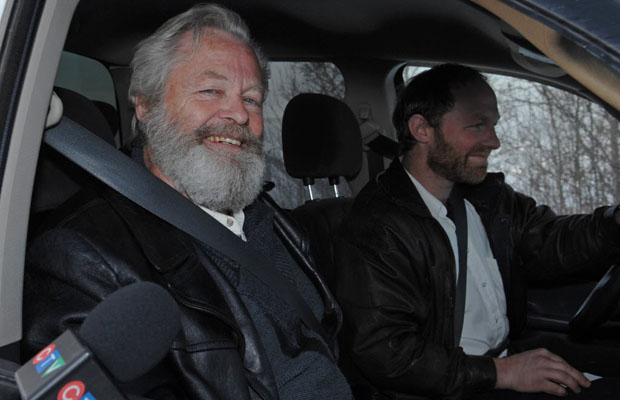Ludwig arrest part of RCMP plan
to assuage local residents
Philip Ling, Canwest News Service, June 16, 2010
In this file photo, Wiebo Ludwig and his son Josh arrive back at his farm near Hythe, Alberta.
Photo: Shaughn Butts, Edmonton Journal.
The RCMP had a highly detailed and carefully scripted communications plan in place prior to the January arrest of convicted oilpatch bomber Wiebo Ludwig in connection with a series of pipeline bombings in northeastern British Columbia.
The strategy — prepared a month before taking him into custody — was designed with the aim to please disgruntled local residents who were angry over what some called RCMP’s “heavy-handed” techniques in the case.
Six bombs have targeted remote EnCana pipelines and wellheads since October 2008. The attacks began after an anonymous letter was sent to local newspapers warning the energy giant to cease its operations in the area south of Dawson Creek, B.C., about 600 kilometres northwest of Edmonton. No one has been hurt in the attacks.
In January, it appeared police may have cracked the case, as about 100 RCMP officers swarmed Ludwig’s farm near Hythe in northwestern Alberta, arrested the notorious oilpatch activist in connection with the attacks and searched his property for days.
But, a short time later, Ludwig was released without charge, despite RCMP insisting they had arrested the right man.
In the nearly 60 pages of documents revealed Wednesday under the Access to Information Act, the RCMP’s hope was to make sure Ludwig’s arrest would address what the force called “concerns and outstanding grievances” between Dawson Creek residents and investigators.
“Some conflicts occurred between local residents and investigators that have resulted in friction and in some cases, a strain on the relationship between the RCMP and the local community,” Insp. Tim Shields, the officer in charge of RCMP’s media relations program in B.C., wrote in note titled “Communications Strategy” on Ludwig’s arrest.
“Accusations have been circulated through the media that investigators have been overly aggressive with local residents in their attempt to obtain voluntary DNA and handwriting samples as well as fingerprints and alibis from persons of interests.”
Shields acknowledged: “There are bridges that need to be re-built between the RCMP and the community. . . . All communications for this case should be developed with the concerns of the local community in mind.”
The note emphasized that “it would be prudent” to invite the mayors of Dawson Creek and nearby Pouce Coupe to the formal media conference because “both are the ground level of community involvement.”
Shields’ strategy included key messaging and a heavily scripted list of answers to potential media questions.
The recommended answer to the question on how the RCMP handled the investigation read like a well-prepared speech: “To those Tomslake residents who feel that our efforts were overly assertive, we are sorry.
“We have a job to do and that job is to stop this series of six bombings before someone in the community is killed,” the response continued. “We can’t do that without talking to people, because as police we have to ask the tough and uncomfortable questions because our job is to investigate and establish the truth.”
In anticipation of the question of whether the B.C. pipeline bombings were the work of the RCMP, Shields suggested the stern reply: “No, absolutely not.”
The RCMP has yet to lay any charges connected to the bombings.
Ludwig is a longtime activist who claimed sour gas wells adversely affected human health, including that of his family members.
Ludwig was released from prison in 2001 after serving two-thirds of a 28-month sentence for five charges related to oilpatch bombing and vandalism.
Eager to see the attacks on its property end, EnCana offered a $1-million prize, a reward that equalled the amount offered after the infamous Air India bombing.
Back to News and Comment page
